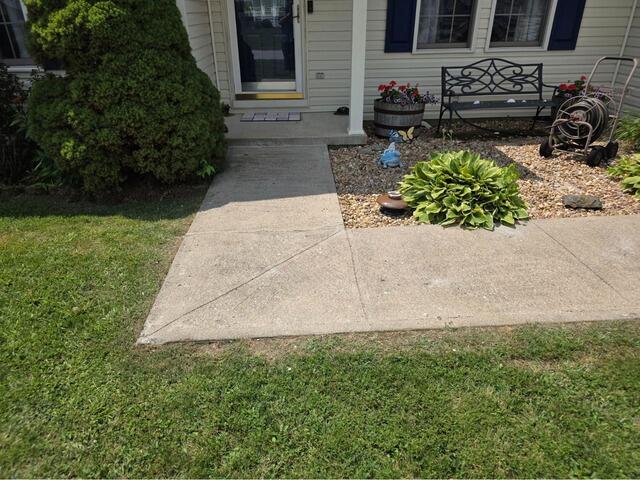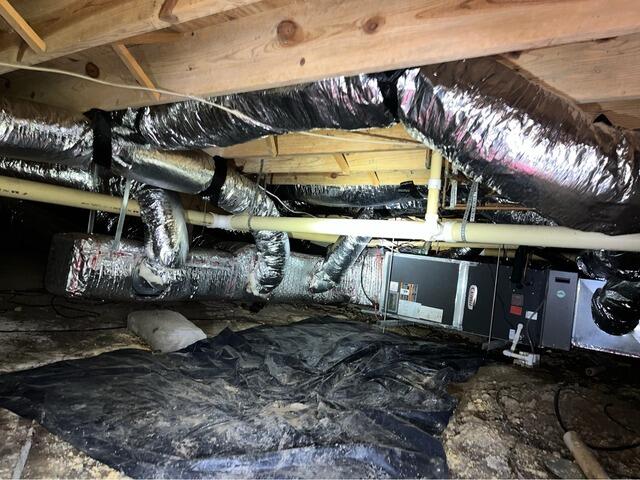The Basement Doctor of Central Kentucky Before & After Photos
Click on a photo to enlarge.
Concrete Repair in Mount Sterling, Kentucky
The sidewalk leading up to this home in Mount Sterling, KY, had a huge gap in it, which could cause someone to trip. We leveled out the gap by injecting all the sunken parts of the concrete with our PolyLevel foam. Our foam is super light, strong, and clean, unlike other mudjacking alternatives. Once all the slabs were stabilized and even, we then sealed the gaps with our NexusPro joint sealant. This sealant really transforms the overall look of the concrete, and it really helps the concrete last longer. The homeowner was super relieved to have the tripping hazard removed, and thought of the boost in curb appeal as an added bonus.
Concrete Repair Contractor in Clay City, Kentucky
In Clay City, Kentucky, the homeowner faced an unlevel sidewalk, posing safety risks and decreasing curb appeal. As you can see in the before photo, certain sections were noticeably sunken. Our team addressed this by utilizing the PolyLevel® system, injecting high-strength polyurethane foam to accurately lift and stabilize the concrete slabs. To prevent future issues, we applied NexusPro® Joint Sealant, effectively sealing cracks and joints. The after photo showcases the polished, level surface that not only enhances safety but also sustains the structure’s integrity over time.
Basement Waterproofing System Installed in Gray, Kentucky
Water leaks had corrupted this basement causing stains, musty smells, and cracks. We relieved this basement in Gray, KY, by draining the foundation of hydrostatic pressure to bring comfort back to this basement. The two most important pieces to our waterproofing system are our subfloor WaterGuard drains and one of our sump pumps. The subfloor drains prevent clogging and help channel groundwater to the sump pump. The sump pump works efficiently to then discharge all the collected water far and away from the home. By relieving this basement of water pressure, the homeowners gained some peace of mind.
Crawl Space Encapsulation in Jeffersonville, Kentucky
Before entering our care, this Jeffersonville, KY, home endured musty odors seeping from its crawl space, compromising both air quality and peace of mind. As vivid in the photos, we revolutionized this space by installing our CleanSpace liner to seal out moisture and our SaniDry Sedona dehumidifier to maintain crisp, dry air. Now, the crawl space not only looks immaculate but also secures the home above from unwanted smells and contributes to a healthier living environment.
Crawl Space Dehumidification System in Jeffersonville, Kentucky
This crawl space in Jeffersonville, KY, was dealing with moisture issues, as evidence by the attached before picture. The floor of the crawl space was muddied, and the air duct system was at risk of deterioration if the moisture was left untreated. We fixed the issue by encapsulating the crawl space with our CleanSpace vapor barrier, but the heart of the system relies on our SaniDry Sedona dehumidifier. You see, when you seal a crawl space off completely, (including the vents) you have to make sure the air stays conditioned so moisture doesn't become trapped in the space. Our SaniDry Sedona system runs automatically, and it is able to remove up to 99 pints of water out of the air in a day if needed be. The crawl space is now dry as a bone, and the homeowner noticed a difference in the air quality above the crawl space almost immediately.
our service area
We serve the following areas
- Albany
- Bagdad
- Bethlehem
- Bradfordsville
- Breeding
- Burkesville
- Campbellsburg
- Campbellsville
- Carrollton
- Columbia
- Dunnville
- Elk Horn
- Eminence
- Finchville
- Fountain Run
- Gamaliel
- Ghent
- Glens Fork
- Gradyville
- Gravel Switch
- Greensburg
- Hestand
- Jamestown
- Knifley
- Lebanon
- Loretto
- Mackville
- Mount Eden
- Mount Hermon
- New Castle
- Pendleton
- Perry Park
- Pleasureville
- Port Royal
- Raywick
- Saint Catharine
- Saint Francis
- Saint Mary
- Sanders
- Shelbyville
- Simpsonville
- Smithfield
- Springfield
- Sulphur
- Taylorsville
- Tompkinsville
- Turners Station
- Waddy
- Willisburg
- Worthville












